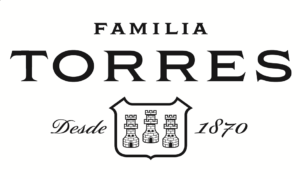
ワイナリーと海のめぐみを堪能
モダニズムな雰囲気が色濃く残るバルセロナの街から出発し、古代ローマ遺跡の街タラゴナまで向かいます。タラゴナはカルソッツ(calçots)、カヴァ、シャトー(xató)などの産地でもあります。途中、モンセラート(Montserrat)、カルドナ城、ソルソナ(Solsona)の歴史的文化財を見ることができます。 ぺネデス(Penedès)地方のぶどう園やワイナリーを見て回り、シッチェス(Sitges)の魅力、アル・バンドレイ(El Vendrell)におけるパウ・カザルスの音楽史についても知識を深めることができます。様々な出会いと発見を経て、最終的にガラフ(Garraf)の海岸とコスタ・ドラダ(Costa Daurada)の北部に到着します。
データ
総距離
462km
区間
6
名所
6
主要なエリア
バルセロナ
モンセラート
ペネデス地方
コスタ・バルセロナとシッチェス
シトー会のルート(La Ruta del Císter)
タラゴナ
区間
第1区間
バルセロナのコスモポリタンアート
バルセロナは、ヨーロッパでも最も多様でハイクオリティな観光プランを提供できる都市の一つとして挙げられます。 世界的に有名なアントニ・ガウディのサグラダ・ファミリア教会や、同じ時代の建築家リュイス・ドメネク・イ・ムンタネーの作品でヨーロッパで最も重要なモダニズム建築とされるサン・パウ病院も見ることができます。もう一人の天才、パブロ・ピカソ足跡をたどって街の中心部を散策するのもおすすめです。19世紀後半から20世紀初頭のバルセロナを感じつつ、彼にインスピレーションを与えたアヴィニョ通りや、 彼が若き日に、サンティアゴ・ルシニョール、ラモン・カザスやガウディと出会ったビール工房兼キャバレーだったクアトロ・ガッツ(四匹の猫)に立ち寄り、ピカソ美術館で作品を鑑賞しましょう。
THE GOTHIC QUARTER
I return to the sea views, climbing to the Mirador de Colón lookout via the elevator installed inside the monument’s column. Once I am back on the street, I round out my visit with a tasting of four Catalan wines: Alella, Pla de Bages, Catalunya and Penedès. As the first street lights flicker on, the night tour of Ciutat Vella and the Gothic quarter begin, visiting Santa María del Pi, the Cathedral and charming plazas like Sant Felip Neri, a place that speaks to the working man’s Barcelona and still has wounds from the tragic Civil War on some of its walls.
BY BICYCLE
The hotel’s rooftop, where my breakfast is ready for me, offers a 360-degree view of Barcelona, from the seaside city to the mountains. I have the beach at my feet, with the Sagrada Familia in the background alongside the modern buildings of the Olympic Village and the Torre Glòries, architectural icons of the Catalan capital’s skyline. The sky is clear, as it is more than 300 days a year; an invitation to cycle through the city streets. The route chosen lets me pedal an unusual bamboo bike past several excellent graffiti art murals.
FOLLOWING IN PICASSO’S FOOTSTEPS
I am taking a little leap through time into the bohemian Barcelona of the late nineteenth and early twentieth centuries, the city where young Picasso wandered the streets. I walk past important places from his life, such as the school where he studied, Carrer Avinyó and the brewery where he had his first solo exhibition. The artist’s work has given me an appetite: taking advantage of the fact that the route ends at the Picasso museum, located in the El Born neighbourhood, I continue a gastronomic tour of the neighbourhood’s iconic taverns. An excellent option to continue the afternoon is strolling through shops, some of which are centuries old, selling handmade goods such as jewellery, fashion, cosmetics, handicrafts, and nougat.
第2区間
モダニズムからモンセラートの空へ
1888年、バルセロナはイルデフォンソ・セルダによる都市開発計画の一環としてアシャンプラ地区を作り、モダニズム建築を作るのに理想的な環境が整いました。 モダニズムは自然からインスピレーションを受けて生まれた芸術様式ですが、その本質に迫る様々なガイド付きツアーが豊富に揃っています。さらに、バルセロナ近郊のサンタ・コロマ・ダ・サルバリョ(Santa Coloma de Cervelló)にあるコロニア・グエル(Colonia Guëll)教会は1890年にガウディによって建築され、産業的モダニズムの複合施設となっています。ここでは、ガウディがサグラダ・ファミリアを設計する前の予行演習となる作品の地下礼拝堂を見学することができます。 次の目的地であるモンセラートへ向かう途中には、カタルーニャ式のアーチ門と丸天井が特徴的なタラサ(Terrassaにあるフレイシャの家(Masia Freixa)など、興味深いモダニズム建築を楽しめます。
A STROLL THROUGH THE EIXAMPLE
I head out early to stroll down the city’s seafront and enjoy the sunrise again. To understand Barcelona’s urban planning a little better, we can go on a private tour with an architect through the Eixample, the urban expansion that connected the old town with the Vila de Gracia, forming a checked pattern that looks as though it were drawn with a ruler. The neighbourhood is home to a large proportion of the city’s heritage-listed buildings, including important modernist works such as the Casa de les Punxes, La Pedrera, the Casa Amatller and the Casa Batlló.
COLONIA GÜELL
I climb to Montjuïc to say goodbye to Barcelona from the heights of its hillside, a spot where you can see the stunning Botanical Gardens, and museums such as the Joan Miró Foundation, the National Museum of Art in Catalonia and the Mies van der Rohe Pavilion.
I set off for Santa Coloma de Cervelló to visit the crypt of Colonia Güell, a spectacular work from Gaudí’s naturalist period. While the crypt is one of the architect’s seven World Heritage-listed buildings, it is also the least well-known work on that prestigious list.
TO MONTSERRAT
Our journey continues north, as we seek to explore the industrial modernist heritage of Terrassa, one of the official Cities and Towns with Character, featuring the Freixa farmhouse with its parabolic arches, and we take a tour of the city’s most outstanding gardens and Visigoth churches. This is an exceptional European heritage site where we can explore centuries of art history.
The next stop is Monistrol de Montserrat, where I take the rack railway to the mountain of Montserrat. This is one of the most iconic and beautiful landscapes of Catalonia, full of powerful symbolism thanks to its monastery and sanctuary dedicated to the Virgen de Montserrat, the patron saint of Catalonia, popularly known as La Moreneta. The mountain woods are impressive, so I decide to stay overnight in the monastery’s lodgings.
第3区間
モンセラートの空からD.Oプラ・デ・バジェス(Pla de Bages)へ
モンセラート修道院博物館を見学した後は、モンセラート自然公園を散策し、カバル・ベルナット(Cavall Bernat)峰のような最も象徴的な岩の周りを歩くことをお勧めします。 バジェス(Bages)方面には サン・リュレンズ・デル・ムン・イ・ルバク(Sant Llorenç del Munt i l’Obac)自然公園があり、 ラ・モラ(La Mola)山がその最高峰の一つとなっています。下り坂をバジェス方面に向かうと、 サン・フルイトス・デ・バジェス(Sant Fruitós de Bages)には、カタルーニャ州で最も保存状態の良い中世の修道院、サン・ベネット(Sant Benet)があります。ワイン好きの方には、モンカウ(Montcau)渓谷の「ティネス・ルート」がおすすめ。ティネスはぶどうを保存する石造倉庫で、このコースでは、DOプラ・デ・バジェスのワインのテイスティングができます。
A BEAUTIFUL SUNRISE
I slept well in Montserrat. At the start of the morning I take a quick tour around the natural park of Montserrat, along paths that encourage peaceful walks and meditation while the first rays of sunlight paint the peaks of the most iconic rocks red, such as the Cavall Bernat, the Serrat del Moro and La Palomera. If the visit coincides with the performance schedule of the Escolania, one of the oldest music schools in Europe, it is worth entering the basilica to listen to how they sing the Virolai, a song also known as Rosa d’abril and dedicated to La Moreneta.
MATÓ AND BACK ON THE ROAD
After visiting the shops around the sanctuary square and buying some traditional mató, a cottage cheese that is delicious with honey, I descend the mountain in the Aeri, a cable car that overlooks the Llobregat valley. Now it’s time to get back in the car and cross the Sant Llorenç del Munt i l’Obac Natural Park. Although I’m tempted by the option of heading to Sant Fruitós de Bages for a tandem jump, free falling from 4,000 metres high, I decide to postpone it for when I come back with friends and can share the adventure.
BAGES
I spend the afternoon on several visits: the Tines of the Vall del Montcau, huge dry stone constructions in which wine was made at the foot of the vineyard when the Bages district was one of Catalonia’s leading producers; the town of Mura, an official Charming Village which retains a spectacular medieval centre in the midst of its cobbled streets and an interesting mill with more than a thousand years of history; and the nearby Sant Benet de Bages monastery, a well-preserved medieval monastery where I can learn how the monks lived between the walls of the church, the cloister and their cells. The complex has incorporated a innovative modern culinary research centre, the Alícia Foundation, which promotes the benefits of healthy eating; three restaurants and a grocery store selling organic products.
第4区間
バロックのソルソナからペネデス地方のアロマまで
ソルソナはカーニバルで知られていますが、カタルーニャのロマネスクで最も重要な彫刻の一つとされる「回廊の聖母礼拝堂(Mare de Déu del Claustre)」が安置されている大聖堂も有名で、中世の街並みもとても重要です。ペネデス地方に向かう途中、カルドナ城からの眺めを楽しんだり、マンレサ(Manresa)やモダニズムの遺跡を散策したりするのもよいでしょう。ペネデス地方に到着すると、ブドウ畑の風景が目の前に広がります。カタルーニャ州で最も広大なDOペネデスでは、カヴァの中心地であるサン・サドゥルニ・ダノヤや、5つの展望台とこの地域を代表するワイナリーが含まれるミラヴィーニャ(Miravinya)・ルートを訪れ、ワイン文化に浸ることができます。
VALL DE LORD
Although Vall de Lord is about twenty miles north of Solsona, this quick detour from our route is worth it. At dawn, the morning mists emerge from the Llosa de Cavall reservoir, whose landscape is great for adventure sports such as climbing, canyoning, paragliding and mountain biking. The play of light filtering through the mist fills my camera roll with striking images. When the sun is warm enough, I rent a kayak to roam those bright turquoise waters. With one last glance at the landscape from one of the bridges across the reservoir, I take the beautiful road that follows the Cardener river gorge to Solsona.
GIANTS IN SOLSONA
During the guided tour of this city, with its strong Baroque heritage, I see strange things like the collection of huge figures in the Giant’s Quarter, huge creatures that parade through the streets during the festive days. The Miracle Sanctuary is barely twelve kilometres from Solsona, City with Character, and its Baroque altar is reason enough to consider a visit. The journey continues southward, entering the province of Barcelona again, with various options for stops, such as Cardona with its castle and salt mines, the Poble Vell de Súria, which rises on the left bank of the Cardener River and was a major community on the salt trade route; or Manresa, City with Character, with its strong modernist heritage.
THE GARDEN OF PENEDÈS
The heart of Penedès, a land with a long wine making tradition, is my next destination. Its vineyard is nestled between Montserrat and the Mediterranean Sea, a landscape marked by gentle undulations of the land and large flatlands, reflecting the waves of the sea that gives it character. In Sant Sadurní d’Anoia I visit the Cava Interpretation Centre, where I discover the history, protagonists, and architecture of this iconic drink through the different rooms. The sprawling Penedès vineyard must have garden fairies, I note in my travel diary after spending part of the afternoon visiting some of the sights of the Miravinya Route, five vantage points with magnificent views over a vine-covered landscape of the Alt Penedès dotted with dry stone walls and huts. I end the day with a vertical tasting in one of Penedès’ legendary wineries, where I learn to appreciate the subtle differences that the passage of time imparts to wine.
第5区間
ワインロードとパブロ・カザルスが遺したもの
ビラフランカ・ダル・パナデス(Vilafranca del Penedès)は、「人間の塔」というカタルーニャの迫力ある伝統行事が行われる広場や、カタルーニャ・ワイン文化博物館(Museu de les Cultures del Vi de Catalunya)、またシャトーが有名です。 ローマ時代に、ワインを海まで運んでいた商業道路であった「ワインロード」はガラフへのアクセスと海辺の町シッチェスを散策するのにも最適です。マリセル美術館で10世紀から20世紀にかけての美術品を鑑賞したり、地元の伝統的なワインであるマルヴァジーアを堪能することもできます。アル・バンドレイには音楽家のパウ・カザルスがかつて夏の別荘として利用していたパウ・カザルス博物館もあり、こちらも必見です。
CATANIAS OF VILAFRANCA
Yesterday was all about the history of Cava, now it’s time for the Vinseum in Vilafranca del Penedès, a museum dedicated to the production of wine in Catalonia, located in an old mansion opposite the basilica of Santa Maria. It is not easy to decide between the great experiences on offer at the Penedès wineries, with different themed visits, activities, and tastings. I opt for a wine and cheese pairing, which offers me the nuanced range of these wines born so close to the sea. Before leaving Vilafranca del Penedès, I go to a sweet shop and buy a few boxes of catanias, a traditional dessert made from toasted, caramelised and chocolate-covered almonds.
THE ELEGANCE OF SITGES
On the way to the coast, driving along the Wine Road, I stop at the Olèrdola castle, a monumental outpost with excellent views of the Penedès plane and Garraf. Sitges, on the official list of Marine Districts and Villages, is one of the most beautiful towns on the Catalan coast. From the promenade, I climb the stairs to the Sant Bartolomeu i Santa Tecla church, located on a small hill that offers panoramic views of Sitges beaches. A walk through the historic town centre with its fresh, whitewashed streets takes me to the Maricel Museum, with its remarkable art collection. As I leave, I make sure to try one of the most unusual wines made in Catalonia, a sweet wine made with malvasía grapes that is still in production thanks to the Fundación del Hospital San Juan Bautista.
THE SOUND OF MUSIC
On the road that skirts the Foix reservoir I cross into a different province, Tarragona, but I remain in the land of the Penedès D.O.. I arrive in Sant Salvador, one of El Vendrell’s maritime districts, home to what was once the summer home of cellist Pau Casals and is now a museum. Through personal objects, I experience the life of this iconic musician and the environment in which he created his work. Pau Casals argued that this house was the expression and synthesis of his life as a Catalan and an artist. I think about the emotion the musician must have felt, the same one I feel now, every time he came back from a trip and ran through the door, straight out into the sea.
第6区間
シトー会のルート、カポーナ(Capona)とタラゴナ
シトー会のルートでは、美しい景色とスピリチュアルの調和を体感することができます。このコースでは、カタルーニャの3つの王立修道院であるサンタ・クレウス(Santes Creus)修道院、ポブレー(Poblet)修道院、バイボーナ・ダ・ラズ・モンジャス(Vallbona de les Monges)などを巡ります。特に、サンタ・クレウス修道院はカタルーニャ王の墓地でもあり美しいステンドグラスの窓が存在感を放ちます。 このルートを進んでいくと、エル・プラ・デ・サンタ・マリアにあるカポーナのルート(la Capona del Pla de Santa Maria)に繋がり、農民が日中休憩するために使っていた石造りの干し小屋を見学することができます。この場所では、DOタラゴナのワインとDOPシウラーナ(Siurana)のオリーブオイルを試飲することができます。 ローマ時代の遺跡や漁村、カタルーニャで最も壮大といわれる大聖堂など、文化の中心地であるタラゴナでこの区間を締めくくります。
CISTERCIAN LANDS
I start the morning on the banks of the river Gaià, at the doorstep of Santes Creus, one of the great Catalan monasteries. Unlike the two other monasteries on the Cistercian Route, now once again inhabited, Santes Creus was abandoned after the Mendizábal disentailment. It was the resting place chosen by two Catalan kings, and inside you can see the impressive royal sepulchres and a remarkable set of stained glass windows.
In the nearby town of Cabra del Camp, I enjoy the guided Nordic walk through vineyards and grain fields. The gentle breeze that makes the crops sway and the pleasant temperature invites introspection, an intimate moment that connects me to the joys of the Mediterranean landscape. The activity ends with the tasting of a DO Tarragona wine and DOP Siurana olive oil.
BACK TO THE SEA
Beautiful country roads surrounded by vineyards take me to Montferri. In a small watchtower stands a shrine by Josep Maria Jujol, who worked with Gaudí. The base of the sanctuary is shaped like a boat that faces the mountains of Montserrat, whose rock formations inspired its shape. I approach the coast again, passing Altafulla, a town with a lovely historical centre, known as Vila Closa, and a seaside district, Les Botigues, that still retains the seafaring character of yesteryear. When I arrive in Tarragona, I walk through the Part Alta neighbourhood and into Casa Castellarnau, a precious example of bourgeois architecture nestled among the noble houses we find on Cavallers Street.
THE GOOD LIFE IN TARRAGONA
On the doorstep of the Cathedral, I wait for the guide who will take me through the different spaces: nave, cloister and a climb to the bell tower, a visit with more intrigue, betrayals, struggles, pacts and secrets than the best TV series. At night, with all its Roman heritage illuminated, I grab a seat in a restaurant with just over half a dozen tables and the open kitchen, where I let myself be guided by young chefs who are very committed to cooking with local products, which means no shortage of natural wines and excellent fish straight from the Tarragona fish market.








